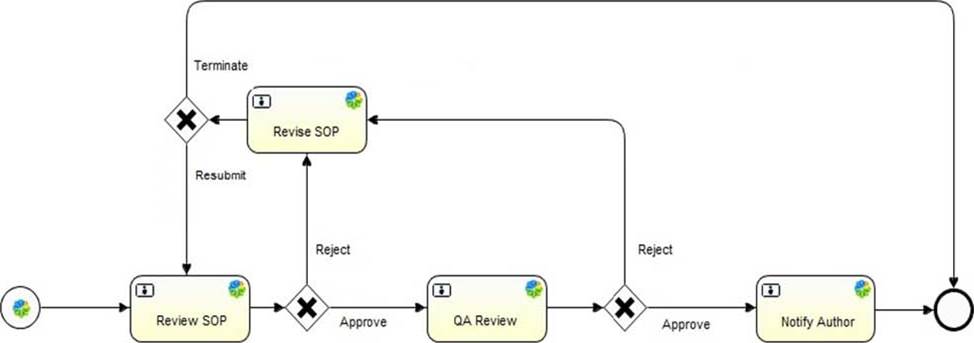Alfresco ACSCE-5X Alfresco Content Services Certified Engineer Online Training
Alfresco ACSCE-5X Online Training
The questions for ACSCE-5X were last updated at Apr 21,2025.
- Exam Code: ACSCE-5X
- Exam Name: Alfresco Content Services Certified Engineer
- Certification Provider: Alfresco
- Latest update: Apr 21,2025
Select two ways to audit Alfresco Content Services events in an Alfresco Content Services extension? (Choose two.)
- A . Mark a method in the extension with an @Auditable annotation.
- B . Open a connection to the database and write the audit information to the audit tables.
- C . Inject AuditComponent into the extension and call recordAuditValues.
- D . Use the Alfresco REST API to record an audit event.
- E . Call the Java Audit Service.
The workflow pictured, shows 3 gateways.

What type of gateways are they?
- A . Exclusive
- B . Parallel
- C . Inclusive
- D . Fork
- E . Join
To which content model entities can a behavior be associated with? (Choose two.)
- A . Aspects.
- B . Types.
- C . Constraints.
- D . Rules.
- E . Associations.
What is Alfresco’s preferred tool for building and packaging an extension?
- A . Winzip
- B . Ant
- C . Maven
- D . Gradle
A scheduled job can execute a piece of logic either by itself or wrapped inside a repository action.
What is the benefit of defining a template action for the scheduled job?
- A . The job can execute a logic that is not related specifically to a node.
- B . The job can execute a logic multiple times, once for each node returned by a query.
- C . The job can execute a logic only once and does a mass update of nodes returned by a query.
- D . The job can execute a logic multiple times on the same specific node.
What are the variable’s scopes available for Activiti workflows?
- A . Process instance and task.
- B . Node and task.
- C . Process instance and form.
- D . Process instance and global.
Which approaches can be used to define a set of reusable metadata fields? (Choose two.)
- A . Define a datalist with the required properties and assign the datalist to each type or aspect through an association.
- B . Define a global type which holds the common properties, then define an association from each type requiring the properties back to the global type.
- C . Define and use the same property names in the different types that need those fields.
- D . Define a base type which holds the common properties and have all the types that need those fields inherit from the base type.
- E . Create an aspect and apply it as a mandatory aspect to all the types which need the properties.
What is the primary use of content rules?
- A . Set disposition schedules for content, as defined in Alfresco Content Services’ default retention policy.
- B . Restrict who can interact with content in a folder that has rules applied.
- C . Set rules on how content is used within Alfresco Content Services and its applications.
- D . Trigger an action in response to new or updated content in the repository.
While implementing an Alfresco Content Services extension, you find you need to pull information out of a document and make it available as content properties.
What type of component would you develop to perform this task?
- A . Content Transformer.
- B . Metadata Extractor.
- C . Alfresco Action.
- D . Metadata Generator.
What is the simplest way to call a custom Alfresco repository JavaScript extension from a content rule?
- A . Create a new custom action that calls my script, and bundle both the custom script and the custom action into an AMP.
- B . Add the script to Data Dictionary/Scripts, then use the “Execute a Script” action to call it from the rule.
- C . Add a function called “executeAction” to the JavaScript and place it on the classpath. Alfresco Content Services will add it as a rule action.
- D . Upload the script to the folder on which the rule action is applied, and name it “ruleScript” so Alfresco Content Services can find it.
Latest ACSCE-5X Dumps Valid Version with 87 Q&As
Latest And Valid Q&A | Instant Download | Once Fail, Full Refund

